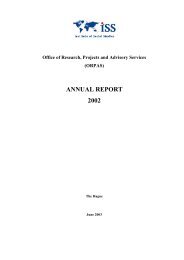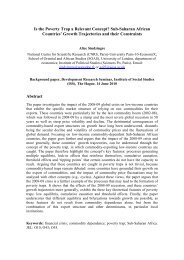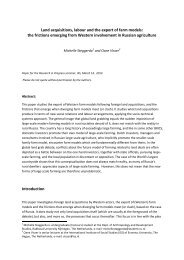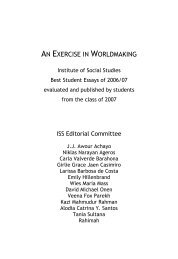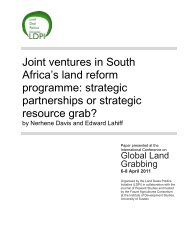AN EXERCISE IN WORLDMAKING 2009 - ISS
AN EXERCISE IN WORLDMAKING 2009 - ISS
AN EXERCISE IN WORLDMAKING 2009 - ISS
You also want an ePaper? Increase the reach of your titles
YUMPU automatically turns print PDFs into web optimized ePapers that Google loves.
9 Tailoring Credit Programs along the Logic of the Poor 105<br />
that although no perfect targeting mechanism exists, the gains to the<br />
poor from targeting should offset the costs.<br />
Since the 1980s, there has been a policy shift in Bangladesh targeting<br />
women in special credit programs. Studies have indicated how increased<br />
income ‘improves the unique livelihood enhancement functions women<br />
perform for their households as brokers of the health, nutritional, and<br />
educational status of other household members’ (Goetz and Gupta,<br />
1996: 46-47). Mayoux (2001: 438-439) points to how the perceived link<br />
between savings and credit provision and women’s empowerment rests<br />
on three assumptions: first, that women would invest in their own economic<br />
activity; second, that this would result in increased well-being for<br />
women and their families; and third, that economic empowerment would<br />
enable women to renegotiate changes in gender relations in the household,<br />
leading to social and political empowerment.<br />
These assumptions are challenged to a large extent. In their research<br />
on gender, power and control over loan use in rural credit programs in<br />
Bangladesh, Goetz and Gupta (1996: 49) found that a significant proportion<br />
of women’s loans were being controlled by male relatives. Out of<br />
qualitative studies of 253 loans to women by four MFIs, the degree of<br />
women’s control was broken down as follows: partial control at 24.1<br />
percent, no control at 21.7 percent, significant control at 19.4 percent,<br />
full control at 17.8 percent, and very limited control at 17 percent. The<br />
findings come with the implication that the pervasive optimism for selecting<br />
women as the main credit beneficiaries should be reconsidered,<br />
given the risks women take in navigating horizontal and vertical relations<br />
within the household and the community.<br />
ZERO<strong>IN</strong>G <strong>IN</strong>: MICROF<strong>IN</strong><strong>AN</strong>CE <strong>IN</strong>NOVATIONS FOR THE VERY POOR<br />
The issue of reaching the very poor is related to targeting and program<br />
design, which are not only ‘hard issue’ tools in poverty alleviation, but<br />
also political activities that affect the poorest. In this sense, the very poor<br />
are discriminated against because they are perceived as credit risks. Having<br />
distinct needs, they function according to a distinct logic: they avoid<br />
putting all their eggs in one basket (or spread the risk by diversifying<br />
sources of income), and make use of survivalist strategies to keep themselves<br />
from slipping deeper into poverty. One way for microfinance programs<br />
to zero in on very poor households is for MFIs to ‘modify their<br />
products so that they are unattractive to non-target households, e.g.,




